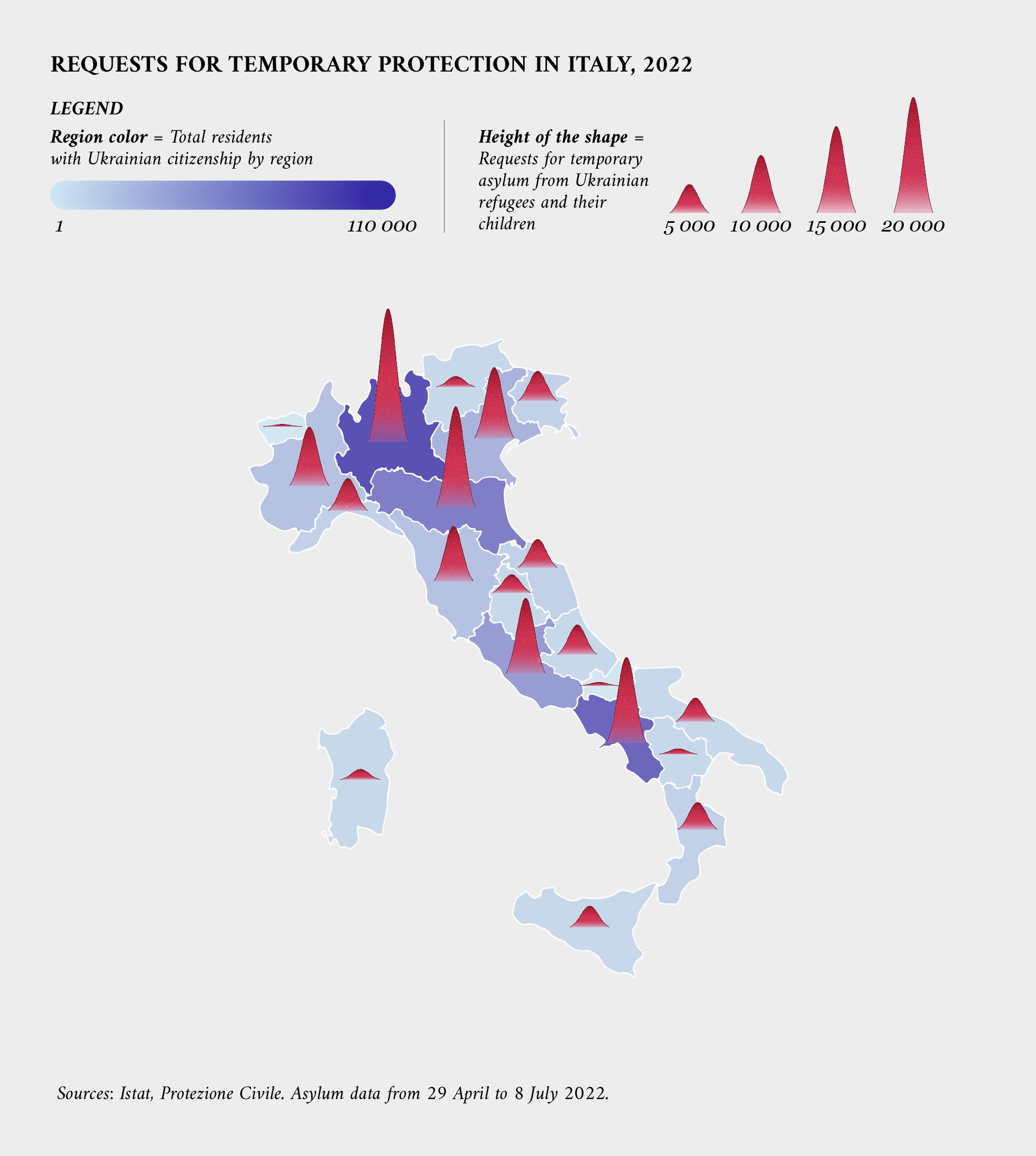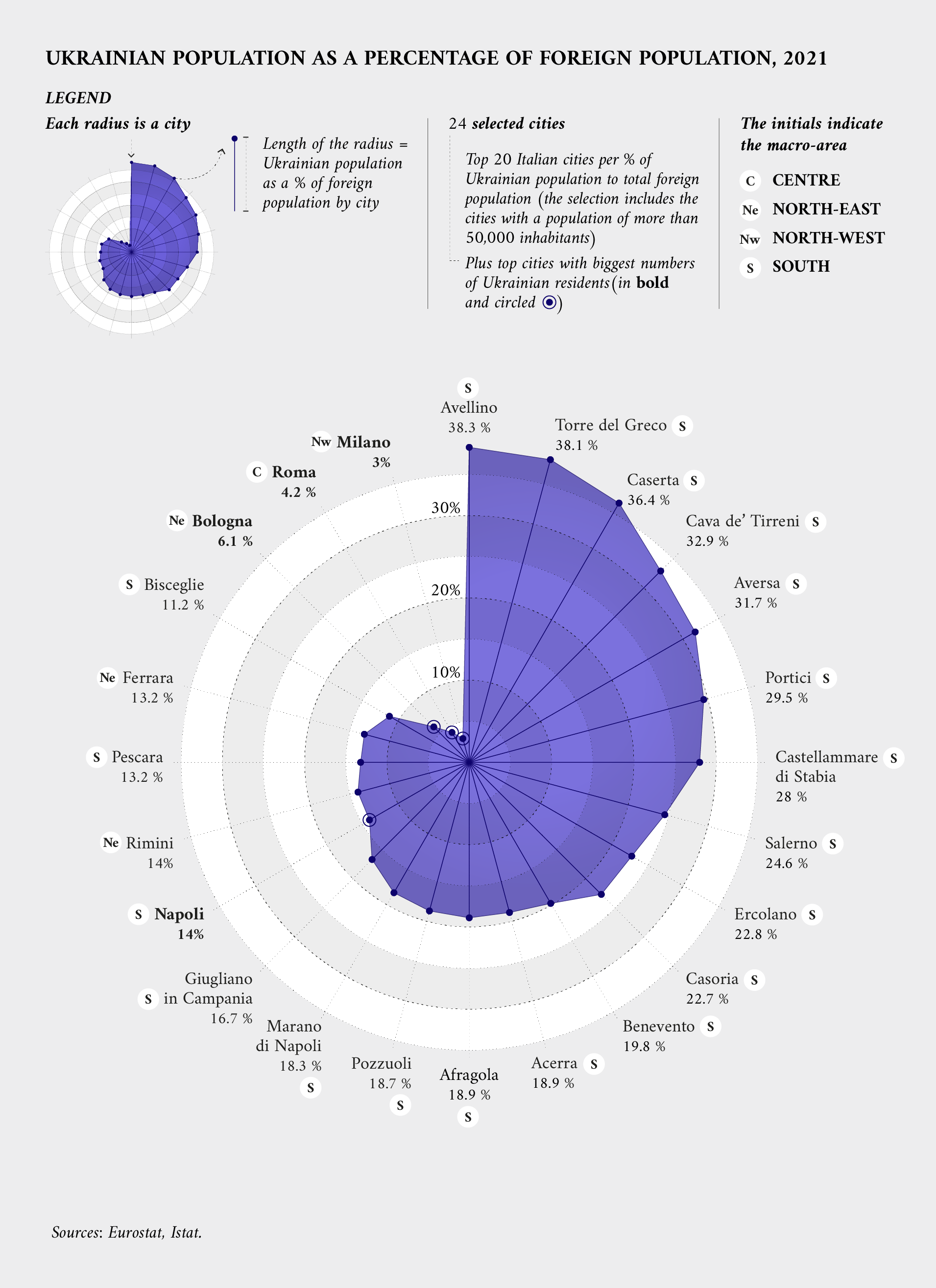Ukrainian diaspora in Italy
Understanding Ukrainian communities in the context of refugee flows
Among the EU Member States, Italy hosts one of the largest communities of Ukrainian-born people. According to Eurostat data, at the end of 2020 there were 223 000 Ukrainian citizens holding a valid residence permit. Only Poland had more, with almost 500 000.
The Eurostat figures show that Ukrainian citizenship is the third most represented nationality from non-EU citizens in terms of residence permits, behind Morocco and Turkey. However, while the last two remained stable or decreased since 2013, residence permits for Ukrainian nationals increased steadily, with a growth of more than 50 % up to 2020.
Over 100 000 Ukrainian refugees sought shelter in Italy after the war started. This makes the country an important case study to understand the Ukrainian diaspora in Italy. Did the refugees go to areas where Ukrainian communities were already in place? And if so, where?
The Italian Civil Protection Agency (Protezione Civile) published data about the distribution of Ukrainian refugees asking for temporary protection in Italian regions. This allows us to map where they were registered and if this influx is consistent with pre-existing Ukrainian communities.
It should be noted, however, that obtaining a residence permit this way is only the first step in deciding where to live. The area in which a residence permit is granted is sometimes determined only by bureaucratic reasons. With such a permit, Ukrainian refugees are free to move anywhere they choose, so the real number of refugees rejoining friends and families is likely to be higher.
That said, agency data shows that from 29 April to 8 July 2022, the four regions with the highest number of Ukrainian refugees were Lombardy (29 000 adults and children), Emilia-Romagna (22 000), Campania (19 000) and Lazio (16 000). These are all areas with a significant presence of Ukrainian communities. In Campania, they represent a large share of the total number of non-EU citizens living in the region.

Furthermore, through the data provided by the Italian National Institute for Statistics (Istat), it is possible to map the largest communities of people with Ukrainians citizenship by city. The largest is in Rome, with 30 000 people. The next two largest hubs (around 15 000–16 000 people) are in Milan and Naples. The fourth largest community, located in the centre-north of the country, is Bologna with 7 600 residents with Ukrainian citizenship.
An important feature highlighted by the data is that these people are mostly girls or women – in fact only one in four is a boy or a man. This is a stark difference from other communities, which tend to have similar numbers for both genders or sometimes – such as for people from Morocco – more men than women.
Generally speaking, foreign citizens tend to live in the northern part of Italy, which is more economically developed. Ukrainians are no exception: out of 235 000 people with Ukrainian citizenship in Italy in 2021, around 130 000 live in this area. The Centre region hosts another 45 000 people, many of which live in Rome, while their presence in the South region is concentrated in Naples, which accounts for a significant part of the 55 000 total Ukrainian residents.
The following chart shows the Ukrainian communities located in Italian provinces and their gender distribution before the war started in March 2022.

Historical data about Ukrainian nationals in Italy shows that most of the growth of this community happened between 2001 and 2011, when it quickly went from 9 000 to 178 000 people. After that, the influx of new people became much slower. It has to be noted, however, that these figures only account for people of Ukrainian citizenship, so that the acquisition of Italian citizenship over time must also be considered.
The biggest Ukrainian communities formed in large urban centres, often (but not always) the capitals of the regions. In those cities, however, Ukrainians represent only a small part of the people with foreign citizenship: 6 % of the total foreign population in Bologna, 4 % in Rome and 3 % in Milan.
The one exception is Naples, where out of 56 000 people born abroad, almost 8 000 (14 %) came from Ukraine. In general, this is true for the whole of Campania, Naples’ region. Campania does not have a very large number of foreigners overall, at least compared to other regions in northern Italy, but in many cities Ukrainians represent a big share of the total immigrant population, ranging from 14 % in Naples to 38 % in Avellino. In fact, if we look for Italian cities with the largest share of Ukrainians out of the total foreign population, 15 out of 20 are in Campania.

Methodological note
In the text and in the second chart, when looking at the Ukrainian population in cities out of the total foreign population, only cities with a population of 50 000 people and over were considered.
The data in this report was chosen to study whether refugees from Ukraine tended to rejoin friends and families in the countries that were hosting them, with Italy as a case study. This was made possible by using data on the number and the gender of people with Ukrainian citizenship for each of the roughly 8 000 Italian municipalities. This information was combined with data about the total population and the total foreign population of each municipality to determine, as a percentage, the share of those groups represented by Ukrainian communities.
Lastly, data from the Civil Protection Agency, available up to province level, was used to check the primary location of residence permits requested by Ukrainian asylum seekers – and if this matched the areas of pre-existing Ukrainian communities in Italy.
To access the data used in this story, you can download it here.
Article by Davide Mancino
Data visualisations by Federica Fragapane
